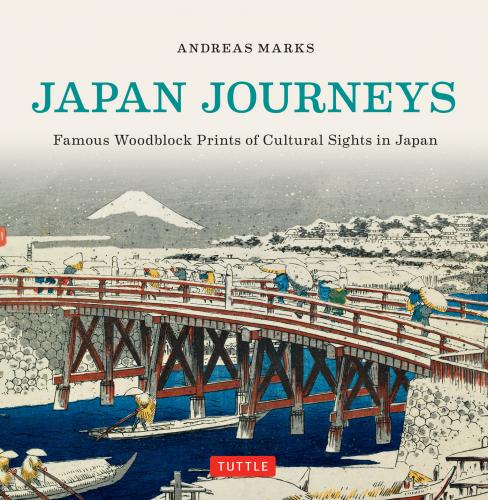Japan Journeys. Andreas Marks
which literally means “Japan Bridge,” was the starting point of all highways that left Edo. It was therefore considered not just the heart of the city but also the heart of Japan. Said to have been originally built in 1603, the bridge that stands today was reconstructed in 1911 and now lies in the shadow of an overhead expressway, which detracts somewhat from any feelings of nostalgia when visiting.
The Nihonbashi area was Edo’s bustling center for commerce and culture. In 1683, this was where the Mitsui family established their kimono store Echigoya, which eventually became the department store Mitsukoshi. This district is today the financial center of Tokyo, home to the Bank of Japan headquarters and the Tokyo Stock Exchange.
A lively scene showing merchants and strollers. 1855, Utagawa Hiroshige, No 1, Nihon Bridge:View of Dawn Clouds, from the series Famous Sights along the Fifty-three stations.
Looking westward from Edobashi Bridge with Nihonbashi Bridge in the background and Mount Fuji in the far distance. 1853, Utagawa Hiroshige, Nihonbashi Bridge from Edobashi Bridge, from the series Famous Places in Edo.
The view from Nihonbashi Bridge toward Edo Castle, with white-walled warehouses lined along the blue waterway. Ca. 1830–1831, Katsushika Hokusai, Nihonbashi Bridge in Edo, from the series Thirty-six Views of Mount Fuji.
Trolley cars cross the modern stone version of the Nihonbashi Bridge with its massive neoclassical iron street lights. 1930, Bannai Kokan, Snow at Nihonbashi Bridge, from the series Fifty-three Stations of a Modern Tokaido.
ASAKUSA
Asakusa is home to Sensoji Temple (also referred to as Kinryuzan Temple, Kinryuzan Kannon Temple, or the Kannon Temple), the oldest Buddhist temple in Tokyo, founded in the year 645 and dedicated to the bodhisattva Kannon. Since 941 its entrance has been dominated by the Kaminarimon—the Thunder Gate—featuring a massive paper lantern painted in red and black.
In the Edo period, Asakusa was an entertainment district. Just a fifteen-minute walk from Sensoji Temple were the pleasure quarters of Yoshiwara, established by the government in the mid-seventeenth century to contain prostitution. Today, with its high concentration of relatively old houses and traditional businesses and festivals, including the Sanja Matsuri, one of the largest festivals in Japan, Asakusa draws many tourists wishing to experience “old Japan.”
On the left of the print is the Main Hall of Sensoji Temple. This structure was destroyed during the Second World War and rebuilt in 1964 in ferroconcrete. 1830s, Keisai Eisen, Picture of the Grounds of the Kinryuzan Kannon Temple in Asakusa, Edo.
1852, Utagawa Hiroshige, Kinryuzan Temple at Asakusa.
The Nio Gate of Sensoji Temple is flanked on either side by two imposing guardian deities. Like the Main Hall, which is directly behind it, the gate was rebuilt in 1964 after being destroyed in the Second World War. Ca. 1815, Utagawa Kuniyasu, Perspective Picture of the Nio Gate of Asakusa in Edo.
View of the entrance to Sensoji Temple from Kaminarimon gate. The pagoda on the left was rebuilt in 1964 and is today on the right. 1856, Utagawa Hiroshige, Kinryuzan Temple in Asakusa (detail), from the series One Hundred Famous Views of Edo.
Asakusa’s Torigoe Shrine is the location of a famous festival that takes place every year in June featuring a procession with a portable shrine (mikoshi) that weighs almost four tons. 1934, Kasamatsu Shiro, Spring Snow— The Torigoe Shrine at Asakusa.
Visitors climb the stairs to the Main Hall of Sensoji Temple, in front of which hangs a paper lantern similar to the one at Kaminarimon gate. 1934, Kasamatsu Shiro, The Great Lantern of the Kannon Temple, Asakusa (detail).
THE SUMIDA RIVER AND RYOGOKU
The fourteen-mile-long Sumida River flows through Tokyo into Tokyo Bay as one of the lower branches of the Arakawa River. The name Sumida first appears in 835, but the river went by several other names until the turn of the nineteenth century, when the name Sumida River was made official.
Several bridges span the Sumida, one of the oldest of which is the Ryogoku Bridge, dating from the mid-seventeenth century. Every summer the river hosts one of the oldest and most famous fireworks displays in Japan.
Конец ознакомительного фрагмента.
Текст предоставлен ООО «ЛитРес».
Прочитайте эту книгу целиком, купив полную легальную версию на ЛитРес.
Безопасно оплатить книгу можно банковской картой Visa, MasterCard, Maestro, со счета мобильного телефона, с платежного терминала, в салоне МТС или Связной, через PayPal, WebMoney, Яндекс.Деньги, QIWI Кошелек, бонусными картами или другим удобным Вам способом.
